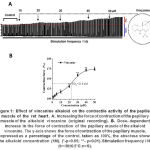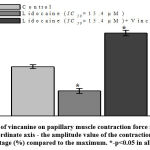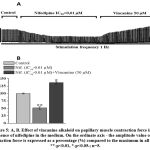Manuscript accepted on :25-11-2022
Published online on: 13-12-2022
Plagiarism Check: Yes
Reviewed by: Dr. Satyajit Mohapatra
Second Review by: Dr. Imtiaz Wani
Final Approval by: Dr. H Fai Poon
Inoyat Z. Zhumaev1*, Sadriddin N. Boboev1, Pulat B. Usmanov1, Shakhnoza B. Qurbonova1,3, Shavkat Yu. Rustamov1, Adilbay T. Esimbetov1, Gulnaz S. Begdullaeva1, Abdisalim A. Zaripov and Shahobiddin M. Adizov2
1Institute of Biophysics and Biochemistry of National University of Uzbekistan,
2Institute of the Chemistry of Plant Substances, Uzbek Academy of Sciences, Tashkent, Uzbekistan.
3Tashkent state pedagogical university named after Nizami, Uzbekistan.
Corresponding Author E-mail: inoyat8585@mail.ru
DOI : https://dx.doi.org/10.13005/bpj/2569
Abstract
In the present study, the dose-dependent effect of the alkaloid vincanine on the contractile activity of rat heart papillary muscle was investigated and it was found to increase the force of muscle contraction at all concentrations. The half-maximal inotropic effect concentration (ED50) of vincanine was 21.8 μM, respectively. Studies of the effect of this alkaloid on the cardiomyocyte Na+-channel in the presence of its blocker lidocaine showed that the positive inotropic effect of vincanine does not involve the Na+-channel. When studying the effect of vincanine on Сa2+L-channels in the presence of nifedipine (IC50=0.01 μM), the positive inotropic effect of vincanine (50 μM) alkaloid was partially reduced. In general, it was found that the positive inotropic effect of vincanine on the force of papillary muscle contraction is partially mediated by Сa2+L-channels and mainly Na+/Сa2+ exchange.
Keywords
Cardiac Muscle; Inotropic Activity; Ion-Channels; Indole Alkaloid
Download this article as:| Copy the following to cite this article: Zhumaev I. Z, Boboev S. N, Usmanov P. B, Qurbonova S. B, Rustamov S. Y, Esimbetov A. T, Begdullaeva G. S, Zaripov A. A, Adizov S. M. Mechanism of Positive Inotropic Effect of Vincanine on Cardiac Muscle Contraction Activity. Biomed Pharmacol J 2022;15(4). |
| Copy the following to cite this URL: Zhumaev I. Z, Boboev S. N, Usmanov P. B, Qurbonova S. B, Rustamov S. Y, Esimbetov A. T, Begdullaeva G. S, Zaripov A. A, Adizov S. M. Mechanism of Positive Inotropic Effect of Vincanine on Cardiac Muscle Contraction Activity. Biomed Pharmacol J 2022;15(4). Available from: https://bit.ly/3Bwpaz3 |
Introduction
It is known that several cardiovascular diseases are directly related to defects and disturbances in the work of various ion channels in heart cells [1; 2; 3]. The rhythmic contraction of the heart takes place depending on Ca2+ ions and is determined by the function of ion channels and receptors located in the cardiomyocyte sarcolemma and SR membrane [4; 5]. During the action potential (AP) in cardiomyocytes, the contraction process begins as a result of the activation of the SR Ca2+-channel of the Ca2+ ions entering through the L-type Ca2+-channel located in the sarcolemma, and the Ca2+ ions leaving the SR binding to troponin-C in the myofilament, and during relaxation, of [Ca2+]i in the cytosol in the sarcolemma located Na+/Ca2+-exchanger and is normalized by the function of SR Ca2+-ATPase [6]. It has been noted that disturbances in [Ca2+]i dynamics in cardiomyocytes [7], as well as changes in the normal function of SR Ca2+-ATPase [8], RyR [9], and Na+/Ca2+ exchanger [10]. Special attention is paid to the biologically active compounds extracted from the plant, which have been used in folk medicine for centuries to treat various diseases of the cardiovascular system. Examples of this include alkaloids, flavonoids, and other biologically active substances [11, 12, 13, 14]. In particular, indole alkaloids are important as a promising source for the creation and production of new cardioprotective agents, distinguished by their diverse structures and wide pharmacological effects. Therefore, the study of the properties of the biological effects of these alkaloids is the basis for identifying potential candidates for the creation of a new generation of cardioprotective agents in the treatment and prevention of ischemic heart diseases. Taking this into account, in our research, the mechanism of the inotropic effect of vincanine on the force of papillary muscle contraction of the rat heart was investigated.
Material and Methods
The studies were carried out on papillary muscle preparations isolated from the right ventricle of outbred white rats weighing 200-250 g. Animals were immobilized under light ether anesthesia, decapitated, after opening the chest cavity, the heart was removed and placed in Krebs physiological solution of the following composition (in mM): NaCl, 120; KCl – 4.8; CaCl2 – 2; MgSO4 – 1.2; KH2PO4 – 1.2; NaHCO3 – 20; glucose – 10, pH = 7.4.). We used papillary muscle preparations isolated from the right ventricle of the heart with an average diameter of 0.5–0.8 mm and a length of 1–3 mm. The muscle preparation was fixed with silk threads in the experimental chamber, and one end was connected to the rod of an F30 isometric sensor (Hugo Sache, Germany). The experimental chamber was perfused with oxygenated (O2 – 95%, CO2 – 5%) Krebs solution at a rate of 6 ml/min. After the stabilization period, the muscle was irritated with rectangular pulses with a frequency of 0.1 Hz and a duration of 5 ms and an amplitude exceeding the threshold by 20% using an ESL-2 electrical stimulator. The amplitudes of elicited maximal isometric contractions were used as the control (100%) and changes in the contractile force after drug action was expressed as a percentage of the maximal response. Contractions were recorded on a chart recorder (TZ 4620, Chech Rep.) and after conversion to digital form stored on a personal computer. Lidocaine was used in the experiments to investigate the effect of Vincanine on the Na+-channel, nifedipine was used on the Сa2+ channel, and NiCl2 was used to study the effect of the Na+/Ca2+ exchanger function.
Drugs and Reagents
Vincanine indole alkaloid was isolated from Vinca erecta plant by Adizov M. Shakhobiddin senior researcher (Ph.D.), at the Institute of the Chemistry of Plant Substances, Academy of Sciences of the Republic of Uzbekistan. Lidocaine, Nifedipine, and nickel chloride were purchased from Sigma-Aldrich Chimie (Sigma, St. Louis, MO, U.S.A.).
Results and Discussion
In preliminary experiments, the dose-dependent effect of vincanine alkaloid on the contractile activity of the rat heart papillary muscle was studied. It was found that this alkaloid has a positive inotropic effect on the contraction activity of the papillary muscle of the rat heart at all concentrations (Fig.1 A). When vincanine alkaloid was examined at a concentration of 5 μM to 50 μM, it was observed that this alkaloid showed a maximum effect at a concentration of 50 μM and increased muscle contraction force by 73.9±3.1% compared to the control (control was taken as 100%). The half-maximal inotropic effect concentration (ED50) of vincanine was 21.8 μM, respectively (Fig.1 B).
 |
Figure 1: Effect of vincanine alkaloid on the contractile activity of the papillary muscle of the rat heart. |
It is known that potential-dependent Na+-channels play an important role in the maintenance and control of Сa2+-homeostasis in cardiomyocytes. Na+ ions affect the work of the Na+/Сa2+-exchanger, and its blocking affects the transport of Сa2+, which increases the release of Сa2+ from the cell during polarization, and inhibits its entry into the cell during depolarization [15]. These changes, in turn, affect SR Ca2+ content, resulting in less Ca2+ release in response to stimulation and reduced muscle contraction force. At the same time, in conditions where the entry of Сa2+ through the sarcolemma Сa2+ channels does not take place, Na+ ions entering through the Na+ channels affect the process of Сa2+ exit from the SR [16]. Under these conditions, Са2+ efflux depends on [Са2+]о, suggesting the involvement of Са2+ entry through the Na+/Са2+ -exchanger.
Taking into account the above, the inotropic effect of vincanine may be related to its effect on the cardiomyocyte Na+-channel. We tested this prediction using the Na+-channel blocker lidocaine. In control experiments, it was noted that lidocaine reduces the activity of muscle contraction in a dose-dependent manner (5-30 μM). In particular, it was observed that lidocaine at a stimulation frequency of 1 Hz and a concentration of 30 μM reduces the amplitude of the papillary muscle contraction force by 83.7±2.5% compared to the control (Fig. 2). In this case, the concentration of lidocaine that reduces muscle contraction by 50% (ID50) is 15.4 µM.
 |
Figure 2: Dose-dependent effect of lidocaine on papillary muscle contractile activity. |
On the axis of the ordinate – the amplitude value of the contraction force is expressed as a percentage (%) compared to the maximum, on the axis of the abscissa – the concentration of lidocaine (μM) is shown, (*-p<0.05; **-p<0.01). Stimulation frequency 1 Hz (t=+36±0.5 oC); n=5.
Reduction of papillary muscle contraction under the influence of lidocaine occurs with a decrease in [Na+]i, an increase in the release of Са2+ through the Nа+/Са2+-exchanger, and a decrease in [Ca2+]i. The addition of vincanine under these conditions did not significantly attenuate papillary muscle contraction (Fig. 3).
 |
Figure 3: Effects of vincanine on papillary muscle contraction force in the presence of lidocaine. |
On the ordinate axis – the amplitude value of the contraction force is expressed as a percentage (%) compared to the maximum. *-p<0.05 in all cases; n=5.
According to the analysis of the results of this experiment, in the presence of lidocaine, the positive inotropic effect of vincanine on papillary muscle contraction activity was preserved, and it can be concluded that this situation is not related to the effect of vincanine on the cardiomyocyte Na+-channel.
It is known that many agents with a positive inotropic effect lead to an increase in the of [Ca2+]i in the cytosol by activating Ca2+L-channels located in the sarcolemma of cardiomyocytes. [17]. One of the main reasons for the positive inotropic effect is the modulation of the activity of Ca2+L-channels in cardiomyocytes, which in turn is associated with the change in the amount of [Са2+]i in cardiomyocyte cells. The positive inotropic effect of vincanine alkaloid on papillary muscle contractile activity of rat heart can be caused by activation of Ca2+L-channels located in the membrane of cardiomyocytes. To clarify this assumption, the positive inotropic effect of vincanine alkaloid was studied in the presence of Ca2+L-channel blocker-nifedipine in the incubation medium. Nifedipine exerted a negative inotropic effect at a concentration of 0.001 μM to 0.1 μM, and its half-maximal inhibitory effect concentration was IC50=0.01 μM when studying the papillary muscle contractile activity of the rat heart (Fig. 4).
 |
Figure 4: Dose-dependent effect of nifedipine on papillary muscle contractile activity. |
On the ordinate axis – the amplitude value of the contraction force is expressed as a percentage (%) compared to the maximum, on the abscissa axis – the concentration of nifedipine expressed in logarithm [Log(M)] is shown (*-p<0.05; **-p<0.01). Stimulation frequency 1 Hz; t=+36±0.5 oC; n=4.
In further experiments, the effect of vincanine (50 μM) on papillary muscle contraction force was investigated under conditions of incubation of nifedipine (IC50=0.01 μM) in the medium. Under these conditions, the positive inotropic effect f vincanine was found to decrease by 31.6±3.6% compared to the control variant (Fig. 5A, B).
According to the analysis of the results of the conducted research, in the presence of nifedipine, it was found that the positive inotropic effect of vincanine and pyrazoline alkaloids on papillary muscle contraction activity was partially reduced. It can be concluded that the positive inotropic property of alkaloids is explained by their partial effect on Ca2+L-channels in cardiomyocytes.
 |
Figure 5: A, B. Effect of vincanine alkaloid on papillary muscle contraction force in the presence of nifedipine in the medium. |
On the ordinate axis – the amplitude value of the contraction force is expressed as a percentage (%) compared to the maximum in all cases; **-p<0.01, *-p<0.05.; n=5.
SR Сa2+-ATPase and Na+/Ca2+-exchange system function play a key role in cardiomyocyte relaxation. Increased function of SR Ca2+-ATPase and Na+/Ca2+-exchange system leads to a decrease in [Ca2+]i content in the cytosol of cardiomyocytes, which in turn increases the rate of relaxation [18].
It is known that the Na+/Ca2+-exchange system in cardiomyocytes in a normal physiological state is the main system that brings Na+ ions into the cell and releases Ca2+ ions out of the cell [19]. Therefore, in the experiments, we studied the effect of these alkaloids on the papillary muscle Na+/Ca2+-exchange. To evaluate the effect of vincanine and pyrazoline alkaloids on papillary muscle contraction activity and the place of Na+/Ca2+-exchange located in the sarcolemma of cardiomyocytes, a concentration of 10 mM of its non-specific blocker – NiCl2 was used. In the presence of NiCl2 (10 mM) in the medium, the positive inotropic effect of 50 μM concentration of vincanine on papillary muscle contraction force was 107.6±4.6%, respectively, compared to the control (Fig. 6).
 |
Figure 6: Effects of vincanine in the presence of NiCl2. |
On the ordinate axis, the amplitude value of the contraction force is expressed as a percentage (%) compared to the maximum. The frequency of stimulation of the drug is 1 Hz. In all cases * – p<0.05; ** – p<0.01.; n=5.
The positive inotropic effect of this alkaloid on papillary muscle contractile activity was shown to decrease by 65.3±4.1% compared to the control condition. Based on this, we can explain this situation by the fact that the positive inotropic effect of vincanine modulates the Na+/Ca2+ exchange.
Conclusion
According to the obtained experimental results, it is possible to assume that the positive inotropic effect of vincanine is partly related to the Ca2+ ions entering the cardiomyocyte through Ca2+L-channels and mainly due to the modulation of the Na+/Ca2+-exchange function in cardiomyocytes [Сa2+]in dynamics.
Acknowledgments
This work was supported by a grant F-ОТ-2021-154 from the Coordinating Committee for Development of Science and Technology under the Cabinet of Ministers of the Republic of Uzbekistan.
Conflict of interest
The authors have declared that no conflict of interest exists.
References
- Bers D.M. Calcium Cycling and signaling in cardiac myocytes // Annu. Rev. Physiol. – 2007 – V. 7. – P. 1798-1821.
- Marks A. Ryanodine receptors in heart failure and sudden cardiac death // J. Mol. Cell. Cardiol. – 2001. – V. 33. – P. 615-624.
CrossRef - Santonastasi M., Wehrens X.H. Ryanodine receptors as pharmacological targets for heart disease // Acta. Pharmacol. Sin. – 2007. – V. 28 (7). – P. 937-944.
CrossRef - Bassani J.W.M., Sarcoplasmic reticulum Ca2+ release channel complex and automatism: A matter of fine tuning // Cardiovasc. Res. – 2007. – V. 75 (1). – P. 7-9.
CrossRef - Bers D.M. Altered cardiac myocyte Ca2+ regulation in heart failure // Physiology. – 2006. – V. 21. – P. 380-387.
CrossRef - Bers D.М. Ca2+ influx via sarcolemmal Ca2+-channels in excitation-contraction coupling and cardiac contractile force // Dordrecht, The Netherlands: Kluwer Academic Publishers. – 2001. – P. 101-132.
CrossRef - Kranias E.G., Bers D.M. Calcium and cardiomyopathies // Subcell. Biochem. – 2007. – V. 45. – P. 523-537.
CrossRef - Kubo H., Margulies K.B., Piacentino V., Gaughan J.P., Houser S.R. Patients with end-stage congestive heart failure treated with ß-adrenergic receptor antagonists have improved ventricular myocyte calcium regulatory protein abundance // Circulation. – 2001. – V. 104. – P. 1012-1018.
CrossRef - Brillantes A.M., Allen P., Takahashi T., Izumo S., Marks A.R. Differences in cardiac calcium release channel (RyR) expression in myocardium from patients with end-stage heart failure caused by ischemic versus dilated cardiomyopathy // Circ. Res. – 1992. – V. 71. – P. 18-26.
CrossRef - Stanley N., Maguy A., Le Bouter S., Yung-Hsin Yeh. Arrhythmogenic Ion-Channel Remodeling in the Heart: Heart Failure, Myocardial Infarction, and Atrial Fibrillation // Physiol. Rev. – 2007. – V. 87. – P. 425-456.
CrossRef - Inoyat Jumayev, Pulat Usmanov, Shavkat Rustamov1 and Sherzod Zhurakulov. Comparative Inotropic Effects of the Some Isoquinoline Alkaloids // Biomedical & Pharmacology Journal, March 2020. 13(1), p. 325-333
CrossRef - Pulat B. Usmanov, Inoyat Z. Jumayev, Shavkat Yu. Rustamov, Abdisalim A. Zaripov, Adilbay T. Esimbetov, Sherzod N. Zhurakulov and Valentina I. Vinogradova. The Combined Inotropic and Vasorelaxant Effect of DHQ-11, a Conjugate of Flavonoid Dihydroquercetin with Isoquinoline Alkaloid 1-aryl-6,7-dimethoxy-1,2.3,4-tetrahydroisoquinoline // Biomedical & Pharmacology Journal, June 2021. 14(2), p. 651-661
CrossRef - F. Ziyavitdinov, U. Zh. Ishimov, N. Sh. Berdiev, I. Z. Zhumaev, I. Oshchepkova, P. B. Usmanov, and Sh. I. Salikhov. Supramolecular Complex of Lappaconitine Hydrobromide and the Monoammonium Salt of Glycyrrhizic Acid: Synthesis, Physicochemical Characteristics, and Antiarrhythmic Activity // Khimiko-Farmatsevticheskii Zhurnal, Vol. 56, No. 2, pp. 25 – 32, February, 2022.
CrossRef - Khilola A. Rakhmanova, Sherzod N. Zhurakulov, Firuza M. Tursunkhodjayeva, Azizbek A. Azamatov, Dilfuza M. Saidkhodjayeva and Inoyat Z. Jumayev. Analgesic and Anti-Inflammatory Effects of 1-(4′-Dimethylaminophenyl)-6, 7-Dimethoxy-1,2,3,4-Tetrahydroisoquinoline Hydrochloride // Biomedical & Pharmacology Journal, June 2022. Vol. 15(2), p. 891-895
CrossRef - Abriel H. Roles and regulation of the cardiac sodium channel Nav1.5: Recent insights from experimental studies // Cardiovasc. Res. – 2007. – V. 76 (3). – P. 381-389.
CrossRef - Scholz A. Mechanisms of (local) anaesthetics on voltage-gated sodium and other ion channels // Br. J. Anaesth. – 2002. – V. 89 (1). – P. 52-61.
CrossRef - Dirk von Lewinski, Sebastian Bruns, Stefanie Walther, Harald Kögler and Burkert Pieske. Insulin Causes [Ca2+]i-Dependent and [Ca2+]i-Independent Positive Inotropic Effects in Failing Human Myocardium // 2005;111:2588–2595
CrossRef - Sheldon E. Litwinand John H. B. Bridge. Enhanced Na+-Ca2+Exchange in the Infarcted Heart // Circulation Research. 1997;81:1083–1093
CrossRef - Donald M. Bers, William H. Barry, Sanda Despa. Intracellular Na+ regulation in cardiac myocytes // Cardiovascular Research 57 (2003) 897–912
CrossRef







